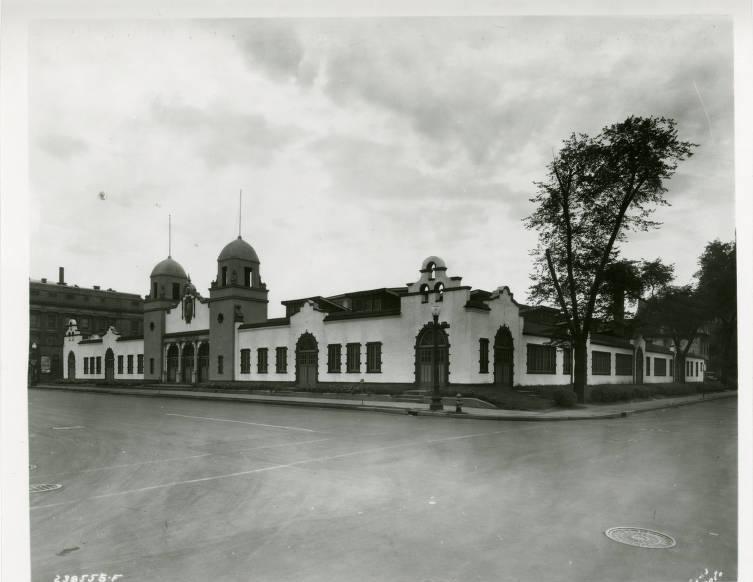Indianapolis served as a center for religious revivalism from the late-19th to mid-20th centuries.

Revivalism is a method whereby a speaker—an evangelist—attempts to bring people to a conversion experience, and acceptance of divine salvation. While periods of religious awakening or revivals have occurred throughout the history of Christianity and are common to many religions, the development of a method that attempts to bring about such an awakening is an American phenomenon, predominantly operating within the Protestant tradition.
The first recorded revival in Indianapolis occurred at Wesley Chapel in 1838 and lasted from March 3 to April 5. At that time Indianapolis had only 6,000 inhabitants and three church buildings—Methodist (Wesley Chapel), Baptist, and Presbyterian. Led by the churches’ ministers and supported by regular members, the revival occurred during a period of particularly harsh weather, yet despite the snow and cold hundreds of people attended nightly. The meetings led to 265 conversions.

In its early days, Indianapolis developed a reputation for coolness to evangelists. One major revival took place between December 1865 and March 1866, under the leadership of Reverend A. S. Kinnan, resulting in 326 conversions. This event was followed in 1869 by a revival led by a Reverend Hammond that lasted for four weeks, but little else seems to have transpired until the last two decades of the 19th century. Indianapolis then experienced three large revivals led by men who had national reputations. These included J. Wilbur Chapman, a Presbyterian minister, director of the Winona Lake (Indiana) Bible Conference, and a colleague of the noted evangelist Dwight L. Moody, and Charles R. Scoville, a Disciples of Christ minister who served as president of the Disciples’ Evangelistic Association.
This period of evangelistic fervor began in 1881 with a major revival held at . Led by the noted boy evangelist Thomas Harrison, the revival lasted from March 28 through June 1881. Although it started slowly because of sleet, snow, and cold during the first week, by April 10 the crowds had grown so large that the church building could not contain them and many were sent home or to other churches. The crowds continued at this level through the succeeding months, and other churches held services at the same time as the revival to handle the multitudes. Organizers claimed 1,218 conversions, with numerous other people committed to church membership.
The increased ease of transportation, the building of larger churches, and a concern for urban evangelism led to the growth of institutionalized evangelistic and revival work in the late 19th and early 20th centuries. In Indianapolis, from 1921 until 1969, , located at the corner of Ohio and New Jersey streets, was the center of revival and evangelistic activity in the city. Built by E. Howard Cadle, a local evangelist and one of the first national radio preachers, Cadle Tabernacle was dedicated by the British evangelist Rodney “Gipsy” Smith on October 9, 1921, as the final act of a 31-day revival that he led.
Cadle Tabernacle represented a kind of permanent revival spirit. Seating 7,000, it was the largest building designed solely for religious services in the country. During its history, some of the most important revivalists in America used its facilities. Oral Roberts brought his faith-healing ministry to the city in 1956, and Bob Jones, Jr., preached at the tabernacle’s anniversary service in 1948. Cadle also regularly undertook evangelistic work there.

One person who did not appear at Cadle was Billy Graham. Even with its size, the Tabernacle could not have held me crowds who flocked to hear him. His crusade in Indianapolis occurred when he was the most famous evangelist in the United States. Held at the , the revival ran from October 5 to November 1, 1959. This crusade, which required nearly three years of planning, held 25 services and attracted over 350,000 people. Graham was at his 1950s best, declaiming on the dangers of godless communism, the immorality rampant in America, and the need to turn to God. This message fell on receptive ears, and by the end of the crusade over 9,300 people had converted.
With the razing of Cadle Tabernacle in 1969 the city no longer had a permanent structure dedicated solely to evangelistic work, but revivalism did not disappear from Indianapolis. Churches committed to spreading the gospel hold revivals as a part of their normal work, and religious ministries dedicated to that goal are often underway in the city. Gospel sings used to be held regularly at the .
At the end of the 20th century and the beginning of the 21st century, the and were regular venues for “PraiseFests” and religious conventions. Since the demise of these two venues, the Indiana Convention Center and Lucas Oil Stadium also sometimes host these kinds of events. While these religious activities take place outside the view of most people, they are well known among the theologically conservative Protestants who make up the majority of their audience.

Help improve this entry
Contribute information, offer corrections, suggest images.
You can also recommend new entries related to this topic.
